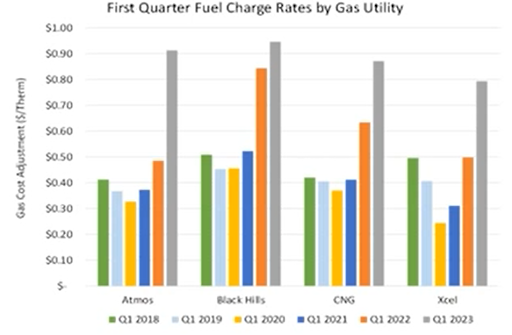A confluence of factors is contributing to the historic increases on energy bills in Colorado.
The Colorado Public Utilities Commission met Wednesday to discuss utility bill affordability this winter. Utility bills in Colorado have nearly doubled since last winter.
Higher gas prices, utility rate increases and cold early winter months created much higher bill costs and elicited a strong public outcry. Erin O’Neill, chief economist for the commission, highlighted a comment from a Longmont retiree who saw a 62% increase on his most recent energy bill.
“It’s hard enough for customers to put food on their tables and pay their bills, and now we are being punished for the need to heat our homes,” the resident wrote.
O’Neill focused on Xcel, the largest utility in the state, but added that the situation was similar across gas utilities. For an Xcel customer, electric bills have increased by 25% over the last year, while gas increased by 75%.
In December 2021, an illustrative Xcel customer would have paid a total of $166 for their gas and electric bill, according to O’Neill. December 2022 was 10 degrees cooler on average, meaning it took more to keep homes warm last month.
Using 2021 rates and December 2022 usage, a gas and electric bill would have been $199 with most of the increase from gas usage. However, rate changes implemented in the last year mean that the illustrative customer actually paid $253 for their electric and gas bill, an $87 increase.
A variety of factors have contributed to this jump in prices. The cost of natural gas went up 40%, while the colder months led to a 30% increase in gas usage.
On top of that, after Winter Storm Uri in February, the utilities commission approved deferring the cost over several months rather than consumers facing high immediate prices, adding another charge that wasn’t there last winter. The commission also allowed Xcel a base rate increase last year.
While all these factors combined to create much higher utility bills, the highest contributing factor is the increased cost of natural gas, according to O’Neill’s presentation. Utilities don’t profit from the gas fuel charges and there’s not much the state or federal government can do as gas prices were deregulated in the 1980s.
O’Neill said gas prices may go down in the near future as natural gas prices decline. However, she cautioned that the gas market remains volatile.
Gail Conners, chief of media relations, outreach and engagement for the commission, highlighted resources for consumers including weatherization and income qualified assistance. People with incomes up to 60% of the state median income levels — $5,539 or less per month for a family of four — may qualify for the Colorado Low-income Energy Assistance Program, which can alleviate the costs of home heating.
Residents can also go to www.211colorado.org to find resources available to them.
Conners added that energy providers often offer budget billing options, which averages the amount a customer pays for their energy bill each month, helping to avoid the pain of seasonal spikes.



